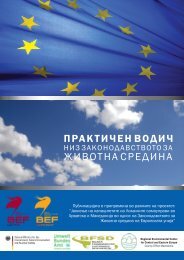The Russian system of chemicals management - Bef-de.org
The Russian system of chemicals management - Bef-de.org
The Russian system of chemicals management - Bef-de.org
Create successful ePaper yourself
Turn your PDF publications into a flip-book with our unique Google optimized e-Paper software.
Editorial<br />
Hazardous substances are a serious threat for human health and the environment and<br />
particularly when reaching water bodies or seas, their <strong>management</strong> is mostly not anymore<br />
subject to responsibility <strong>of</strong> one state alone. While insi<strong>de</strong> the European Union, many<br />
processes are on-going to streamline the activities in the member states for the protection<br />
<strong>of</strong> the environment from the dangers <strong>of</strong> hazardous substances, the cooperation with<br />
non-member states, with different legislation on hazardous substances, as well as own<br />
interests causes additional challenges for a joint protection <strong>of</strong> a shared water body. A<br />
particularly vulnerable sea is the Baltic Sea — with a unique eco-<strong>system</strong> but vulnerable<br />
to pollution due to its special geographic and hydro-morphological conditions being connected<br />
to the ocean only through the extremely narrow Danish belts which hin<strong>de</strong>r the<br />
water exchange — surroun<strong>de</strong>d by eight member states <strong>of</strong> the EU and the <strong>Russian</strong> Fe<strong>de</strong>ration<br />
taking part in implementation <strong>of</strong> agreed EU environmental regulations.<br />
<strong>Russian</strong> classification <strong>of</strong> hazards <strong>of</strong> <strong>chemicals</strong> substances differs largely from the EU,<br />
especially with regard to environmental hazards which are not addressed by <strong>Russian</strong><br />
regulation. <strong>The</strong>re is a lack <strong>of</strong> knowledge among the <strong>Russian</strong> scientific community and<br />
other stakehol<strong>de</strong>rs about the environmental concerns as for instances laid down in the<br />
EU Water Framework Directive and as background motivation for selecting certain substances<br />
un<strong>de</strong>r REACH. However, also vice versa there is a lack <strong>of</strong> knowledge at EU<br />
stakehol<strong>de</strong>rs about the current <strong>Russian</strong> hazardous substance regulatory frame and related<br />
practices to reduce and/or control hazardous substances uses and emissions.<br />
Efficient control and <strong>management</strong> <strong>of</strong> hazardous substances, however, can only be<br />
achieved, if both si<strong>de</strong>s speak the same language. As this document will show, there are<br />
many seeming similarities between the European Union and the <strong>Russian</strong> Fe<strong>de</strong>ration,<br />
however, the background and the <strong>de</strong>tails are different, and over the past <strong>de</strong>ca<strong>de</strong>s European<br />
Union policy makers have gone many steps further, e.g. acting preventively and not<br />
to wait until scientific evi<strong>de</strong>nce proves the danger <strong>of</strong> a certain substance, just to mention<br />
one crucial point. Although, there are clear signs, as we will see further on, that the current<br />
legal framework in Russia in the process <strong>of</strong> fundamental revision, it will certainly still<br />
remain in force for some years, and therefore in the following chapters, the current legal<br />
background and its procedures <strong>of</strong> <strong>management</strong> <strong>of</strong> hazardous substances and ensuring<br />
chemical safety will be explained for audience from the European Union, who seek for<br />
cooperation with <strong>Russian</strong> stakehol<strong>de</strong>rs from public administrations and business. <strong>The</strong><br />
European in mind <strong>of</strong> the authors are respresentative <strong>of</strong> competent authorities <strong>of</strong> EU<br />
members, as well as European institutions seeking for cooperation on reduction <strong>of</strong> certain<br />
hazardous substances (e.g. to the Baltic Sea environment), business partners from<br />
tra<strong>de</strong> and industry in need <strong>of</strong> un<strong>de</strong>rstanding the <strong>Russian</strong> hazard classification <strong>system</strong>.<br />
<strong>The</strong> document would like to provi<strong>de</strong> background information for the EU rea<strong>de</strong>r to enable<br />
them to un<strong>de</strong>rstand the conceptual thinking behind the current <strong>Russian</strong> <strong>system</strong> <strong>of</strong> <strong>chemicals</strong><br />
saftety. It is not meant to be a gap analysis <strong>of</strong> the <strong>Russian</strong> <strong>system</strong> in comparison the<br />
8 | <strong>The</strong> <strong>Russian</strong> System <strong>of</strong> Chemicals Management



